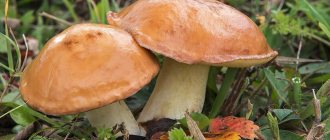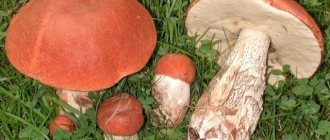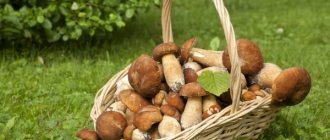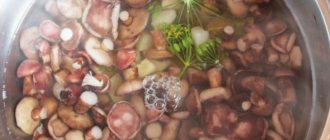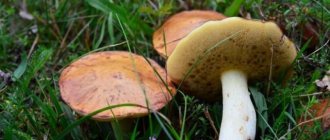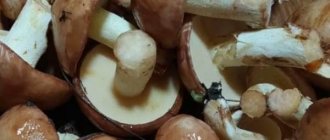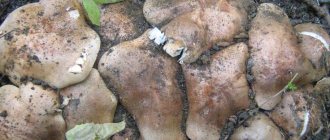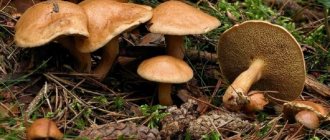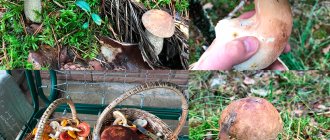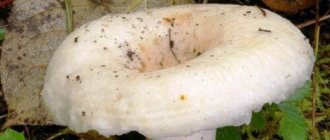Hi all! Among the popular folk mushrooms, it is worth noting boletus, as they grow in almost all forests and begin to bear fruit in June.
This type of mushroom can be collected before frost, so people actively collect boletus throughout the summer and autumn. Although, these same mushrooms can be called one of the most wormy. But I like their taste, just like honey mushrooms.
Another advantage of butter is that they can be pickled, salted, dried or frozen for the winter. And the choice of dishes with them is great: from soups and stews to fried ones.
When to pick boletus mushrooms
More than thirty species of boletus grow in Russia, Ukraine, and Belarus. These mushrooms can be found even in Africa, although only in some regions.
The mushrooms get their very name due to their interesting cap: if you touch it, it feels oily and very slippery, sticks to your fingers, small or medium in size and wet.
The common oiler is widespread in coniferous forests - it is the main home of this fungal family.
Experienced mushroom pickers know that the butter mushroom season begins in June and can last until late autumn, when the first frosts begin.
In August, the harvesting season is in full swing, especially after heavy rains. It is believed that a couple of days after good rains you can collect a lot of mushrooms.
But in warm and dry weather, collecting boletus is not recommended, as they will quickly outgrow. Therefore, it is better to choose the next day after rain, but keep in mind that if the weather is hot, this will speed up the spoilage of the harvest.
Plus - worminess, which also greatly spoils the harvest.
But with experience they know that collection can be started already from the beginning of the summer season, that is, from the first days of June, but the most delicious boletus mushrooms are those that appear after the rains in August and September.
In total, three main waves can be identified when the active growth of the boletus mushroom family occurs: the first is approximately in mid-June, the second is after the July rains, and the third occurs in the second half of August and all of September.
The growth period of these mushrooms is very long, but the specific time when the oil can begin to appear depends on the climate and weather conditions of the desired region.
So, in the Moscow region, the harvesting season for this type of mushroom begins in early June and lasts until the first days of October.
But it’s worth trying to have time to harvest in September, since by the end of the first autumn month there will be very few boletus left in the forest.
In the northern parts of the country, growth also begins in June and can last until the very end of October, and in some cases, in the absence of cold weather, you can also collect some mushrooms in early November.
In general, in all regions of the country, the most productive time for collecting boletus is August and September, especially immediately after the rains. But it must be taken into account that there should not be significant cold snaps when the soil freezes.
Therefore, experienced gardeners choose these two months in order to harvest the best and most delicious harvest of butter in the forest.
Kinds
It is worth noting that it is important not only to know when boletus is collected, but also to take into account what kind they are. Of course, most often you can find the standard true oiler, which in scientific terminology is called late, but in addition to it there are also larch and granular ones. Mushroom pickers often don’t care which mushrooms to pick, since they are all valuable specimens of the second category, distinguished by a pleasant taste and smell.
Where do boletus mushrooms grow, in which forests?
Productive places where this type of mushroom grows are not so difficult to find: they mainly grow in coniferous forests, where there is enough sun, there is a lot of moss and there are no swamps. Good myceliums are usually found immediately under pine trees.
Experienced mushroom pickers know that these mushrooms can also be found in mixed forests, where the so-called late oiler grows. It is also sometimes found in deciduous forests if the soil is not too wet. In order to find enough mushrooms, you need to choose the right time after the rains and go to the coniferous forest, where there are young trees of these species. Pine, cedar and larch are oily friends; without such neighbors, mushrooms will not grow fruitfully.
The day of mushroom picking should be warm, but not hot, as an excessively scorching sun will ruin the entire harvest for the mushroom picker.
It is recommended to collect the oil can a couple of days after the rain. They do not grow in swamps, but the family can also be found at the edge of the forest.
Growing
Amateur cultivation of your favorite mushrooms can be established, but for this there must be suitable conditions. If there are at least a few coniferous trees on the dacha plot, then growing boletus will most likely give results, since they can form mycorrhiza only if such conditions are met.
Did you know? The global mushroom industry market in 2005 was valued at more than $45 billion. Now this figure has increased by almost 10%.
Next, you will need to buy mushroom mycelium, which was obtained in the laboratory, or independently collect spores of adult mushrooms in the forest. Then you will need to prepare the optimal soil (with humus). Sow the mycelium and carry out care (first of all, make sure that the soil is not dry).
Description of the oiler mushroom
Butter can is incredibly beneficial for humans, as it contains carbohydrates, amino acids, fiber, essential oils and lecithin, which can prevent cholesterol deposition.
All elements are necessary for the body and are well absorbed. Experts advise using these mushrooms when you have headaches.
Mushrooms can be called specific in taste, but most mushroom pickers love this pleasant aroma and slightly sour taste. During cooking, the mushroom develops a taste similar to chicken meat.
The fruit body is considered a dietary and low-calorie product, so anyone who wants to lose weight or is simply watching their excess weight can safely prepare it.
It should be noted that the mushroom contains a large amount of protein, even slightly more than in beef or fish.
The benefits of oil can are undeniable: it helps strengthen the immune system, protects the body from diseases and viruses, which is especially important in the fall.
Mushrooms also normalize the functioning of the nervous system, so they are recommended for those who have nervous disorders or insomnia. Also, the fruiting body perfectly fights migraines and helps protect the body from cancer.
However, it is not recommended to give mushrooms to children, since this in itself is a heavy food, and in children the digestive system is not yet strong enough and some foods, including boletus, can provoke poisoning.
Benefits for the human body
Mushrooms contain a huge supply of useful substances, so sometimes people even start growing them at home. In folk medicine, lotions based on mushroom infusions and decoctions are recommended for dermatological problems in the early stages.
- Home-grown boletus is also very useful, because specimens grown in environmentally friendly places can have the following positive effects on the body:
- stimulate the immune system due to antibiotic substances contained in the mushroom cap;
- fight infectious diseases;
- remove uric acid from the body (especially important in the treatment of gout);
- normalize hormonal levels (due to lecithin content);
- increase the level of hemoglobin in the blood;
- improve the condition and performance of the thyroid gland;
- normalize the activity of the nervous system, while simultaneously improving a person’s mood and emotional state;
- eliminate headaches and even migraines;
- participate in the process of liver cell regeneration;
- increase potency in men;
- speed up recovery after injuries and surgical interventions.
- prevent the development of cardiovascular diseases and diseases of the musculoskeletal system.
Few people will undertake to grow boletus at home, but collecting them in their natural growing environment is not at all difficult. The main thing is not to miss deadlines in the summer and autumn, and also decide in advance where it is better to go for the mushroom delicacy. By observing the general rules of “quiet hunting” and strictly following all the requirements for preparing butter, you will be able to reap a good harvest.
How to distinguish edible boletus from false ones
Beginning mushroom pickers often confuse edible and false mushrooms. You need to be able to distinguish them to avoid poisoning.
Thus, an edible mushroom is characterized by the presence of a mucous (moist and oily) cap, which usually has a brown tint. In a young fruiting body, the lower part of the cap has a pale film, which then breaks off and remains in the shape of a ring on the stem of the mushroom.
A noteworthy fact is that the lower part of the cap of the edible mushroom has a tubular texture with small pores, while the false butterdish has a lamellar structure with a gray tint.
Of course, for an experienced mushroom picker it will be easy to understand where the real mushrooms are. But novice mushroom pickers should first carefully study each mushroom, the color and texture of the cap.
It wouldn’t hurt to feel the mushroom cap well. The false mushroom usually has a different shade of cap: it is not quite brown, but rather a little purple.
Butterfish have no dangerous counterparts; at least, only poisoning can occur. But it’s better to play it safe and study mushrooms until you gain experience in this area.
Possible dangers
The special structure of mushrooms and their porous structure contribute to the rapid absorption of harmful substances from the air. For this reason, even edible boletus collected in environmentally unfavorable areas turns into poisonous. They cause poisoning, accompanied by stomach upset, nausea, vomiting and fever. It is important to know that the cap absorbs the most toxins.
Improperly prepared mushrooms are poorly absorbed by the body, so it is important to adhere to the rules for preparing butter. In addition, it is advisable to exclude this product from the diet of young children and people with digestive disorders and chronic diseases of the gastrointestinal tract (3).
How to properly collect (cut) boletus
An amateur mushroom picker should know that if the summer was hot without rain, then most likely there will be few mushrooms and they will be collected until the end of September at the latest.
In this case, you should hurry to catch at least some part of the harvest. If the flesh under the cap is not gray in color, then the mushroom can be safely collected for food.
It is better to collect in the morning, when the sun is not yet actively shining. This will help the harvest last longer, since under the sun the mushrooms will quickly begin to wither and disappear. It is not recommended to pick the mushroom; it is better to carefully cut it with scissors or a knife (sharp) so as not to damage the root system of the mushroom family.
Otherwise, mushrooms will no longer grow in this place next year. Experts advise putting mushrooms in wicker baskets with their hats down for better preservation.
Some people collect in a bucket, but this way the boletus may begin to disappear faster. Once the harvest is at home, it will need to be immediately inspected, washed thoroughly and cooked in any convenient way.
For long-term storage, you can marinate or freeze mushrooms.
Processing mushrooms after harvest
Before cooking or freezing, it is important to properly prepare the harvested crop: to do this, it is necessary to remove the brown peel and rinse well under running water, since the mushroom has a coloring pigment with a not very pleasant taste.
The peel may not be able to be removed, in which case you should pour boiling water over the mushrooms and then immediately place them in cold water - this will help quickly get rid of the skin.
Then you can start cooking in any way. If this is cooking, then it is enough to cook them no more than thirty minutes after they have been thrown into boiling water. Before marinating, you should also cook the butter for about twenty minutes.
Cleaning the mushroom must begin from cap to stem, removing all dirt as you go (especially under the cap itself). If the mushrooms are still very young, then it is not necessary to remove the thin peel from them. It is also important to peel the mushrooms only when they are dry so that they do not slip out of your hands.
Real
The most common are true boletus. Which ones to collect, everyone decides for themselves.
The cap of the mushroom reaches approximately 12 centimeters in diameter, and at first it is semicircular in shape, but over time it becomes convex. In wet weather, the cap becomes covered with a kind of mucus, but in dry weather it becomes shiny and acquires a brownish color.
The edges of the cap are combined with the stem by a special white film, which opens as the mushroom grows, as a result of which a ring is formed on the stem. On the lower surface of the cap there is a tubular light yellow coating, and it can be quite easily separated from the base. The pulp is white, does not change its color when scrapped, and also has a rather pleasant mushroom smell, in some cases similar to the aroma of apples.
